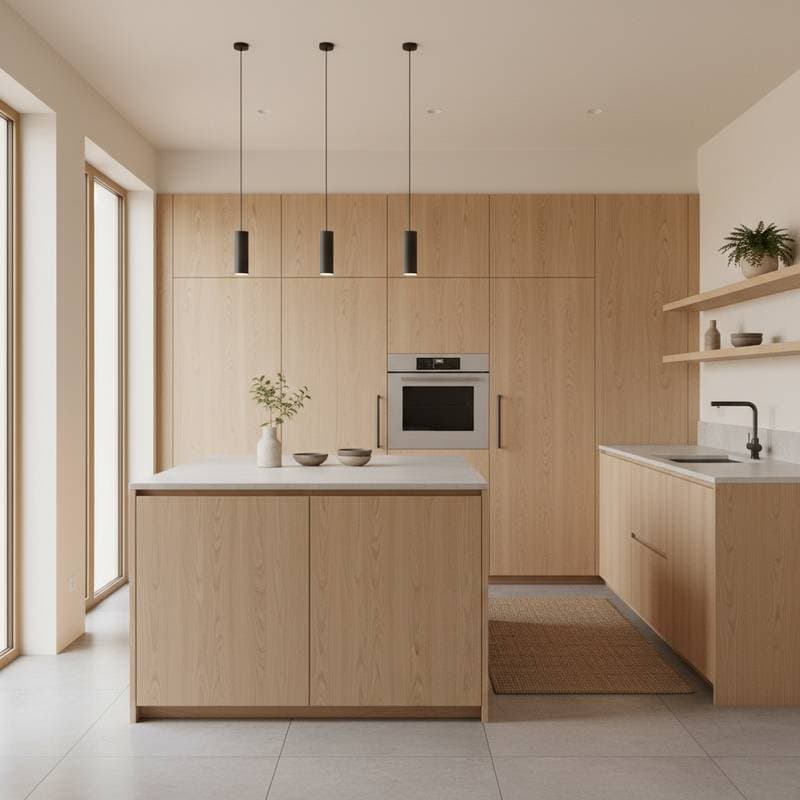Why Handleless Japandi Cabinets Maximize Storage
Kitchens cluttered with protruding handles often appear cramped and chaotic. Handleless Japandi cabinetry counters this by integrating Japanese minimalism with Scandinavian warmth, resulting in sleek surfaces that enhance storage capacity while promoting a sense of calm and order. This approach yields kitchens that feel expansive, hygienic, and remarkably functional for everyday demands.
The Subtle Space-Saving Advantages of Handleless Design
Handleless cabinets in the Japandi style reclaim space through understated innovations. Traditional handles extend one to two inches outward, and in a setup with twenty doors, this projection can consume nearly three feet of usable area. Removing them allows for broader pathways, accommodation of larger prep surfaces, and simplified surface wiping.
Mechanisms such as push-latches, integrated finger grooves, or subtly beveled edges serve as handle alternatives. These features incur a modest additional cost of a few dollars per door yet eliminate visual and physical obstructions. The resulting flush panels enable tighter spacing between cabinet runs and support the addition of extra drawers without encumbrance.
Beyond practicality, these smooth facades distribute light uniformly, which enlarges the perceived scale of compact kitchens. The aesthetic remains inviting rather than stark, thanks to visible wood grains, linen-like laminate textures, and subdued matte varnishes that infuse warmth into the clean lines.
Consider measuring the projection of your existing handles and multiplying by the number of cabinets. This calculation often reveals opportunities to recover several inches of countertop real estate through a transition to handleless configurations.
How Japandi Principles Enhance Storage Efficiency
Japandi cabinetry prioritizes balanced proportions and intentional utility, ensuring that drawers, shelves, and dividers optimize every available volume. Designers frequently elevate base cabinets by one to two inches to incorporate toe-kick drawers ideal for storing flat items like baking trays or cutting boards. Upper cabinets extend nearer to ceilings, yielding 10 to 15 percent additional cubic footage.
The absence of protruding elements facilitates the integration of pull-out organizers and vertical partitions, as sliding components face no interference. Interior systems typically feature modular components, allowing reconfiguration to adapt to evolving household requirements.
In a standard medium-sized kitchen, such layouts can deliver up to 15 square feet of extra storage. Front surfaces become 20 to 30 percent smoother, minimizing dust accumulation. Cleaning routines accelerate by 5 to 8 percent, free from the need to navigate around knobs.
When designing a Japandi kitchen, specify full-extension drawers and adjustable shelving to your cabinetmaker. These elements ensure comprehensive utilization of internal dimensions.
Budgeting for Handleless Japandi Cabinetry
Expect costs for handleless Japandi cabinets to range from $320 to $550 per linear foot, influenced by material selections and mechanism complexities.
Key pricing components encompass push-latch or recessed pull systems at $8 to $30 per door, solid wood facades from $180 to $300 apiece, laminate or veneer alternatives at $90 to $160 each, and soft-close enhancements for $25 to $45 per drawer.
Although upfront expenses exceed those of conventional framed units, the design reduces ongoing maintenance, handle replacements, and hinge repairs. Foregoing hardware also cuts refinishing expenditures over time.
For cost efficiency, blend genuine wood on exposed fronts with laminate sides to target approximately $400 per linear foot while preserving the streamlined aesthetic.
Obtain detailed quotes that delineate materials, hardware, and labor. Identifying areas for minor material swaps can trim expenses without compromising the minimalist integrity.
Installation Options: DIY Versus Professional Expertise
Achieving the flawless alignment essential to handleless cabinets demands exacting precision; even a one-millimeter misalignment disrupts the seamless appearance.
DIY installation suits projects where you possess a laser level and tolerance for meticulous adjustments, particularly in compact kitchens or linear wall setups using pre-drilled flat-pack units with straightforward guides.
Professional involvement proves essential for custom push-latch integrations, continuous channel systems, or embedded lighting. It also addresses challenges like irregular walls requiring scribing techniques.
Experienced installers bill $60 to $110 hourly, totaling $1,200 to $2,500 for a complete kitchen over one to three days, based on scope.
Inquire about warranty provisions for hardware alignment from your installer. Minor shifts may occur, and initial-year adjustments are commonly covered.
Pitfalls to Sidestep in Handleless Designs
Minimalist executions falter when minutiae receive insufficient attention.
Common oversights involve inadequate finger clearance, rendering doors difficult to operate; prototype testing prior to full production mitigates this. Glossy surfaces invite fingerprints, so opt for matte sheens in busy areas to resist smudges.
Enclosed panels risk moisture retention near appliances; incorporate subtle vents or apply dampness-resistant coatings. Inconsistent hardware selections, such as pairing push-latches with grooves, fracture visual continuity; uniformity across units maintains harmony.
Omitting integrated lighting can flatten the space; under-cabinet fixtures accentuate lines and add depth.
Assemble a sample board incorporating finishes, lighting, and mechanisms before final orders. This visualization averts expensive post-installation fixes.
Everyday Benefits of Japandi Cabinetry
Beyond aesthetics, Japandi handleless cabinets reshape daily kitchen interactions. Handle-free surfaces promote clutter-free counters and precise door positioning. Maintenance streamlines, as grease finds no crevices to linger.
Users frequently note a calming transformation in the environment, fostering mindful cooking and hosting. The design's intentionality cultivates a less frenetic atmosphere over time.
Anticipate up to 10 percent greater usable storage relative to traditional setups. Allocate $320 to $550 per linear foot, incorporating durable upgrades. Engage professionals for expansive or bespoke installations. Select uniform materials and subdued finishes to facilitate effortless care.
